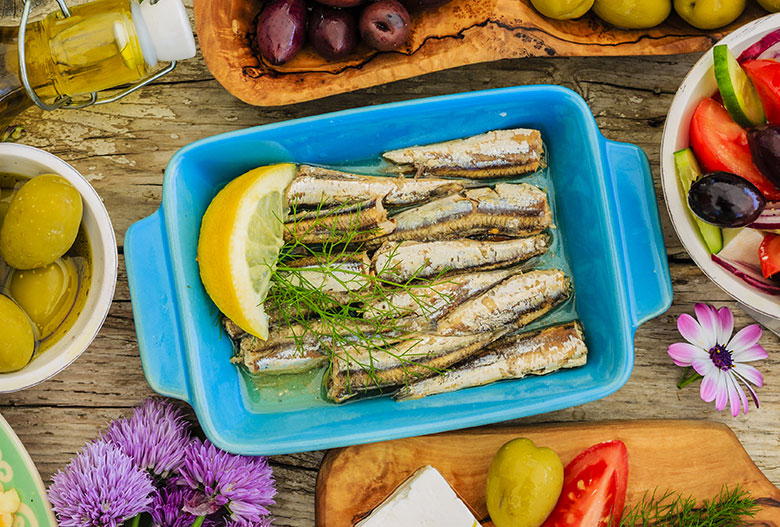- Fish is healthy source of protein — but oily fish has even greater levels of cardiovascular benefit.
- Oily fish include salmon, trout, tuna, mackerel, sardines, herring and anchovies.
- When purchasing fresh fish look for shiny, firm flesh, and mild smell. Many frozen fish taste good too.
- Most fish are best simply prepared, allowing the natural flavor and freshness to shine through.
Fish is a relatively healthy source of protein. However, not all fish have the same level of benefit. The so-called “oily fish” have a greater benefit on cardiovascular health than white fish. These oily fish have higher levels of omega 3 fatty acids, which have been shown to reduce the incidence of heart attacks, sudden death and to reduce inflammation. Oily fish include salmon, trout, tuna, mackerel, sardines, herring and anchovies.
Many MedChefs recipes list salmon or trout as the main ingredient because they are the most readily available, but all of the other fish we mentioned are great substitutions and are easily interchangeable with the other recipe ingredients. With a little practice you’ll see how easy and fun it is to try a variety of fish from the market and create delicious meals.
Fresh fish is always best for flavor and texture, but there are great options for frozen fish if fresh fish is not readily available where you shop.
When buying fresh fish there are a few simple things to look for that indicate freshness and quality. Always look for fish with shiny, firm flesh. It’s color should be bright but natural looking. If buying a whole fish, the eyes should be clear and almost “alert.” All fresh fish should smell like clean water, slightly briny, or even like cucumbers, free of any pungent aromas.When buying frozen fish be sure to buy it in packaging that is good condition. Look to make sure there isn’t any freezer burn or ice crystals on the fish. Often, freshly caught fish is flash-frozen right on the boat, so none of the benefits of fresh fish are lost. Allow frozen fish to thaw overnight in the refrigerator and gently pat it dry with a kitchen towel before cooking.
Ok, now we’re ready to have some fun and get cooking. Most fish is best simply prepared, allowing the natural flavor and freshness to shine through.
Keep in mind that no matter which cooking method you use, all fish will continue to cook a little bit once taken out of the pan, oven, steamer, broth or off the grill. This happens because fish is high in protein and relatively low in fat. The cooking time will vary slightly depending on the shape, size, and weight of your piece of fish, as well as the cooking temperature. One quick tip is to look for small white specs on the side of the fish while it’s cooking. This is a good indication that your fish is ready to eat.
Baking — A simple, “hands off” method that allows you to do other kitchen prep while the fish is in the oven. Baking is a gentle way to cook fish and results in a delicate texture, allowing for the natural, healthy oils to come out, keeping the fish moist.
Grilling — Great for meatier fishes such as salmon or tuna. It lends a wonderful smoky flavor to your meal and it’s a fun way to cook. To ensure your fish doesn’t stick, make sure the grill grates are clean and very hot. Then rub a kitchen towel, with a little olive oil on it, to the grates just before putting the fish on.
Pan Searing — Great for any type of fish to create a crispy exterior while locking in the natural flavor of the fish. The secret is using a pan that can pre-heat really hot, like stainless-steel or a cast iron. It takes a little practice but the results are delicious!
Poaching/Steaming — This method uses a seasoned broth or steam to slowly, gently cook the fish with no added fat. By simply incorporating some herbs, vegetables, or a splash of wine to your poaching liquid or steamer pan you’ll infuse those beautiful aromatics into your fish. Any leftover poaching liquid can be used to make a delicious fish stock too!
Whichever cooking method you use, often just a squeeze of lemon, a drizzle of a simple vinaigrette, or even some chopped, fresh herbs is all you need to finish off a beautifully cooked piece of fish. All of our fish recipes are just that… simple, delicious and heart healthy.

